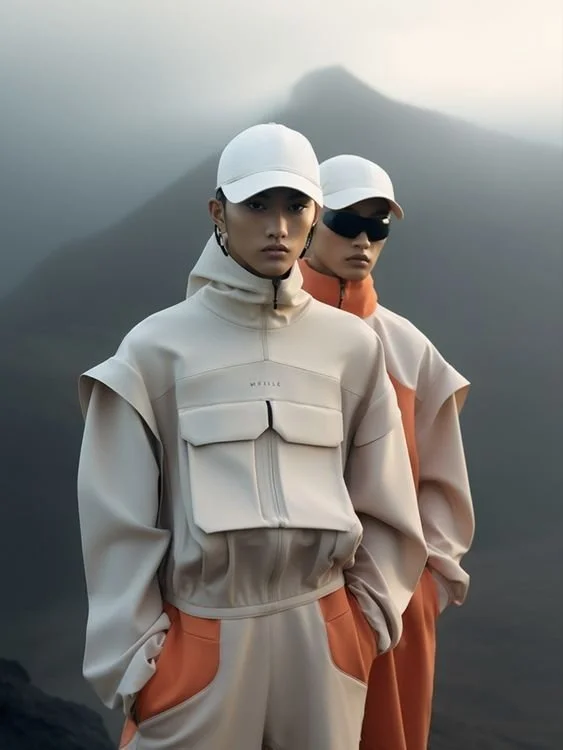Functional Fashion. Can Good Style Still Be Functional?
How AI and Other Movements Are Influencing Fashion.
Fashion has always been about more than just clothes. Beyond color palettes and runway trends to how well pieces perform in daily life, functional fashion promises to bridge the gap between looking good and living comfortably, but it comes with both benefits and drawbacks.
On the positive side, functional fashion offers clothing that works with real life. Items like water-resistant jackets that still look sharp, sneakers with cushioning that hold up for city commutes, or pockets that are actually deep enough to hold more than a lip balm. These innovations respond to a clear demand, consumers are busier and more mobile, and they want pieces that keep up. Yet not every attempt succeeds. Sometimes function crowds out style, leaving clothes that feel practical but uninspired. Other times the claims outpace reality, with “moisture-wicking” shirts that still feel heavy or eco-friendly promises that fall short of true sustainability.
Do consumers want more of this? The answer seems to be yes, but with nuance. Shoppers value versatility. A jacket that works for both work and weekend, or a pair of pants that stretch comfortably without losing shape, feels like a win. At the same time, many still prioritize how a piece looks above all else. Function is a strong supporting act, but rarely the whole show.
Fabric Innovations and Sustainability
Innovation is driving much of this shift. Fabrics that recycle ocean plastics, plant-based leathers, and high-tech blends that regulate temperature are making their way into mainstream wardrobes. Recycled polyester has become common in performance apparel, while bio-based materials like Piñatex (made from pineapple leaves) and Mylo (a mushroom-based leather alternative) are entering luxury collections. Patagonia and Allbirds are often cited for their sustainability-first approach, while Uniqlo and Lululemon focus on balancing comfort, performance, and accessibility. According to McKinsey’s The State of Fashion 2023 report, more than 60% of global consumers consider sustainability an important factor in their purchase decisions.
Up and coming brands are pushing the conversation further. Vollebak, a British brand, is creating clothing with futuristic materials like solar-charged jackets that glow in the dark and garments designed to last for decades. Pangaia develops bio-based textiles such as natural fiber blends and plant dyes, positioning itself at the intersection of fashion and science. Nuuwaï, based in Germany, uses apple waste from the juice industry to create its vegan leather bags. These younger labels highlight how much room there is for innovation beyond the giants of the industry.
The Nuances of Gender in Functional Fashion
What matters most differs by audience. Male buyers often emphasize practicality: durability, technical fabrics, and ease of maintenance. A man may gravitate toward a weather-proof coat he can wear for years without fuss. Female buyers, while also valuing practicality, frequently show higher demand for balance between style and function. For example, pockets are a long-discussed issue in womenswear, where function has historically lagged behind aesthetics. Women are also leading in demand for sustainable fashion, pressuring brands to align with values as much as utility. These differences reflect cultural expectations and the ways fashion has traditionally served each group, rather than innate preferences.
How AI Is Reshaping Functional Fashion
Artificial intelligence is adding a new layer to how functional fashion develops and reaches consumers. AI is helping brands design smarter products by analyzing huge amounts of data about fit, comfort, and consumer preferences. For example, AI-driven tools can predict how fabrics will behave under different conditions, speeding up prototyping and reducing waste. Companies like Stitch Fix have been using algorithms to personalize recommendations, while others use AI to forecast demand and optimize supply chains, lowering the risk of overproduction.
AI is also playing a role in sustainability. By modeling life cycles of garments and materials, designers can make more informed choices about durability and environmental impact. Brands such as The Yes (an AI-driven shopping platform acquired by Pinterest) show how AI can connect consumers with products that meet both style and performance needs.
The Tension Between Promise and Reality
Still, there is a balance to strike. Overly tech-heavy products risk alienating consumers who just want reliable, good-looking clothes. Functional fashion has to live up to its claims while staying wearable and affordable. Otherwise it risks being dismissed as a gimmick.
The Bottom Line
Functional fashion is not a passing trend. It is a response to how modern life demands both performance and expression from what we wear. The future will be shaped by sustainable fabrics, new innovators, and the growing role of AI in design and retail. The real challenge lies in understanding which pieces of function matter most to which consumers. For some, that may be high-performance fabrics. For others, sustainability and design-forward looks matter more. Either way, the key takeaway is simple, it is important to know your customer.
Sources:
McKinsey & Company. The State of Fashion 2023.
Business of Fashion. “The Next Wave of Sustainable Innovation in Fashion.”
Vogue Business. “How AI Is Transforming Fashion Design and Retail.”
Vollebak official site.
Pangaia official site.
Nuuwaï official site.
Reach out and set up some time to chat about your community and communications. Download a complimentary copy of our latest report.








